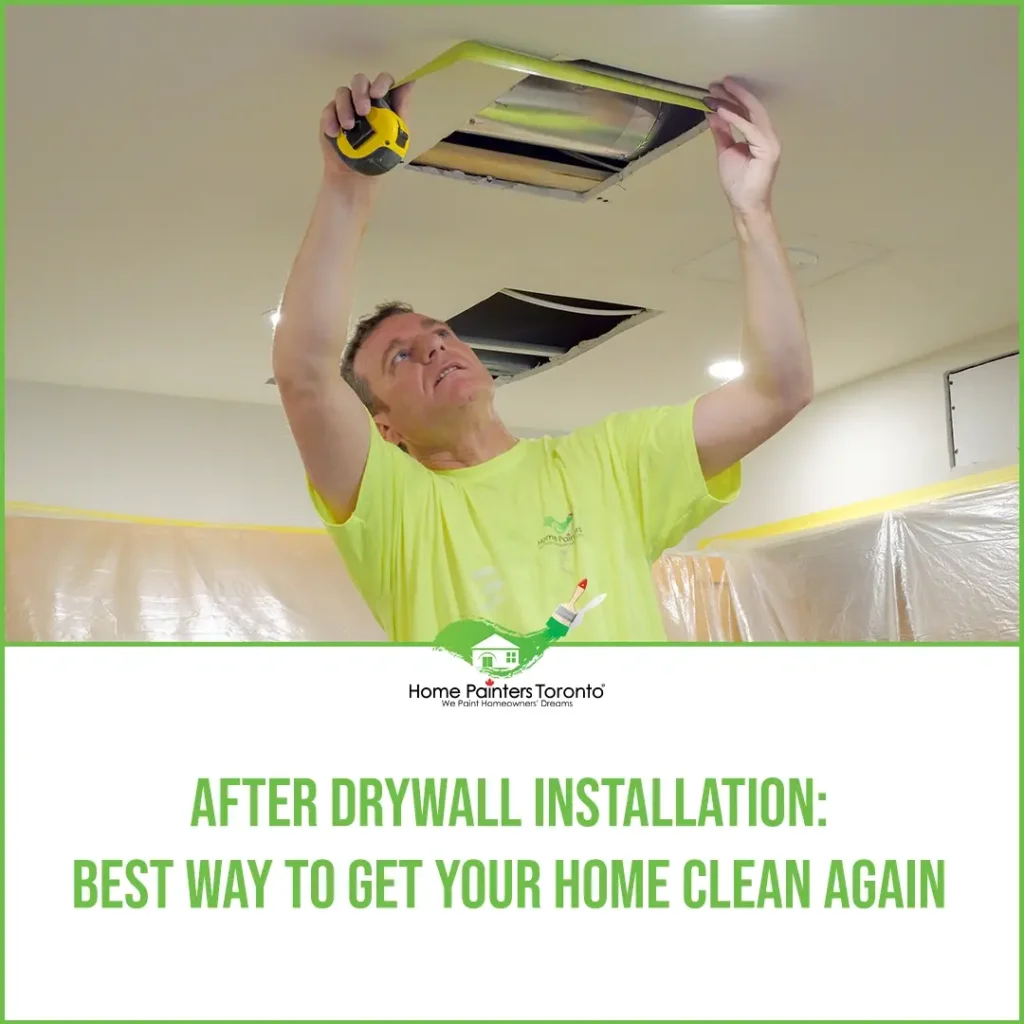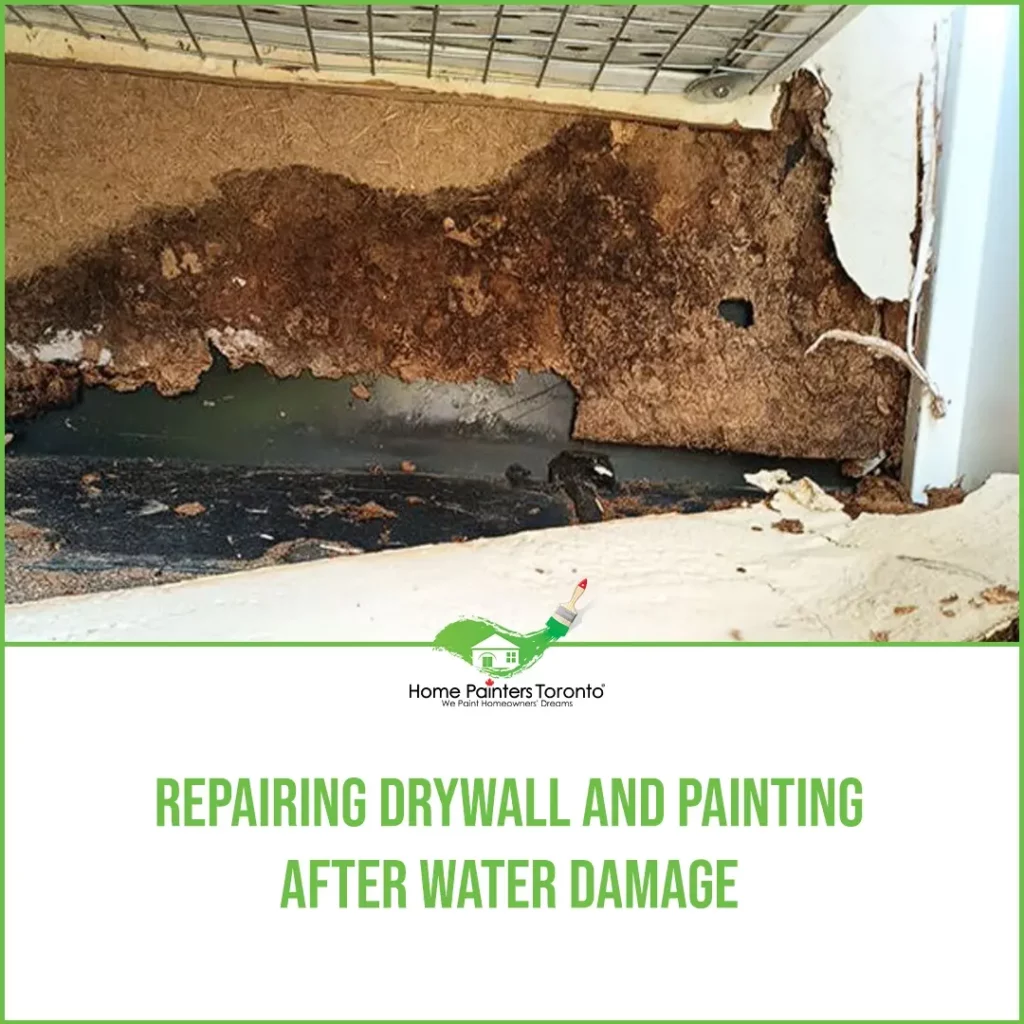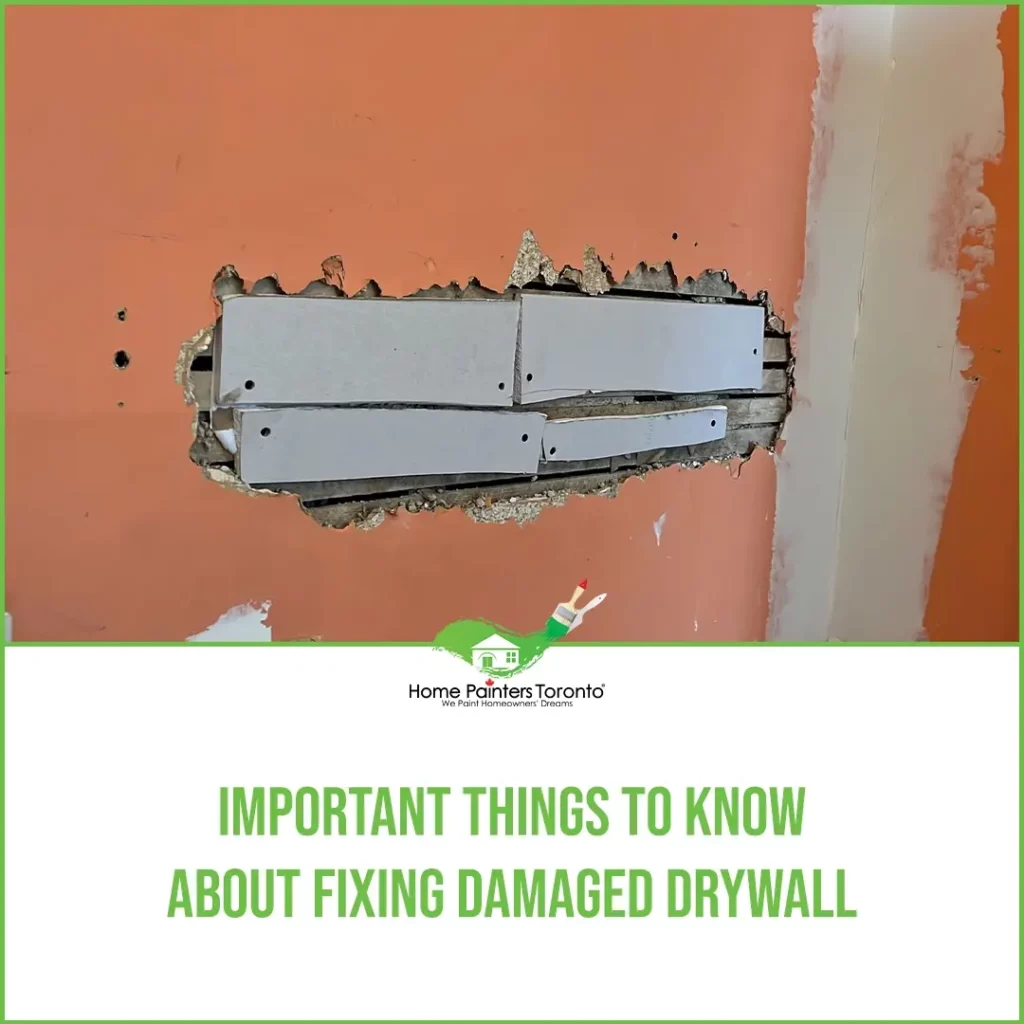
Is water seeping into your walls? What to look for and what to do next.
If you suspect you have a leak in your home that is seeping into your walls, it can be stressful. As a homeowner, you want to ensure you’re taking care of water damage at the earliest possible moment. Water coming in contact with your drywall can be disastrous if it goes on for too long.
Here are some tips for identifying if you have a leak and what to do next.
How to Identify Potential Leaks
When water seeps through pin-sized holes in your plumbing or small cracks in your pipes, it will take the easiest path down to the ground. You may find that the framing in your walls will be the path of least resistance. Using a moisture meter or infrared camera to check for leaks can be extremely helpful. Some of the signs you may have a leak include puddles on the floor near your walls, wet or damp drywall, discoloured drywall, damp masonry, mould or mildew, musty smells, or water-stained trim. Notice any of these issues, it’s best to start investigating the source of the leak immediately.
Potential Sources of the Leak
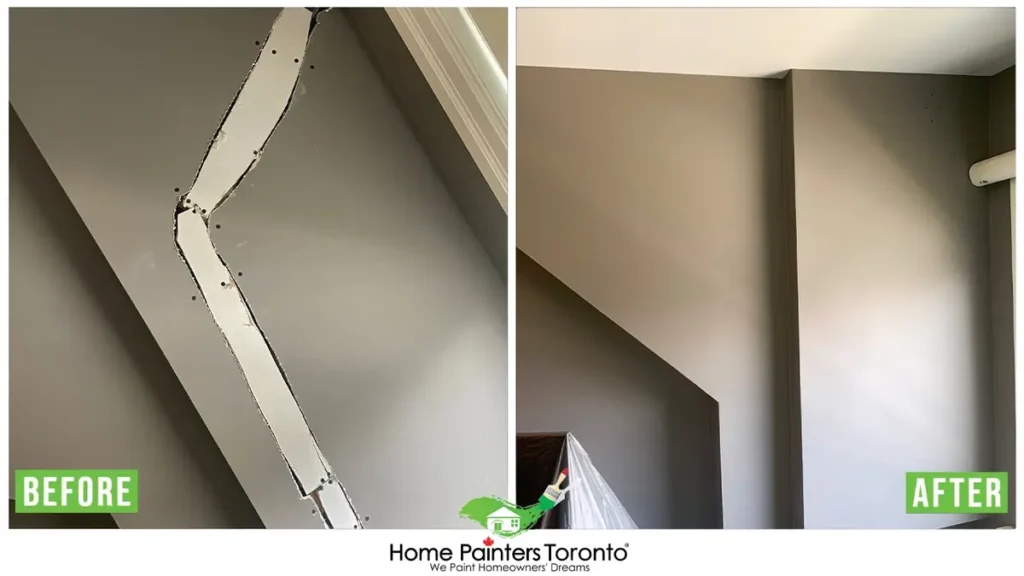
Supposing you have any of the above symptoms of a leak, you’ll want to figure out exactly where the source is. It can take some time and even require the help of a professional. There are a few interior and exterior spots that can be the source of your leaking water headache.
Assuming you suspect it’s coming from your interior piping, you can try to find it by:
First: Turning off all your faucets and appliances that require water.
Second: Write down the number on your water meter.
Third: Wait three hours, and if the usage increases, you have a leak on your hands.
Admitting you happen to have a toilet that runs or a leaky faucet, this method may not be as effective for you.
Suppose you suspect the leak is coming from the exterior of your home. In that case, there are a few places it could be coming from.
Regularly checking your downspouts, gutters, caulking, windows, chimneys, vents, and doors will help you keep tabs on any damage that could lead to leaks. Suppose you’re experiencing water damage in your basement. In that case, you may even have below-grade issues, like sprinkler issues, french drains, grading, and improper drainage.
Knowing When to Replace Vs. Repair Seepage-Impacted Walls
Water seepage can transform your once-sturdy walls into compromised structures. Yet, there’s no need to panic. Pat yourself on the back for catching the issue, and let’s delve into your options: repair or replace. Here we break down when each approach is appropriate, arming you with the knowledge needed to make an informed decision.
Assessing the Severity of Damage
The first step involves understanding the depth of damage:
- Surface Damage: If the seepage has only affected the surface – causing paint or wallpaper to peel, for example – the core structure might be undamaged. Repairs such as repainting or re-wallpapering, after addressing the source of seepage, are often sufficient in these cases.
- Ongoing Dampness: If walls remain damp over extended periods despite fixing the seepage source, it is a signal of significant water intrusion. Longer-lasting moisture can cause structural issues, including rot in wooden walls.
- Serious Structural Weakening: In more extreme cases, water seepage may result in crumbling plaster, buckling drywall, or wood rot. These indicate severe damage and often call for new wall replacement.
How to Repair Leaks
Once you’ve determined the source of your leak, you must prevent as much water damage as possible. Assuming the leak is coming from inside your walls, you should call a professional plumber. They will need to remove the drywall and fix the leak. If you’re looking for the best drywall repair and interior painting in the GTA, Home Painters Toronto can help you with your project for the best price. There are a few different solutions on how to fix water seeping through walls, depending on where the leak is. Supposing your gutters are clogged and your downspouts aren’t draining, you’ll want to ensure you clean those out once or twice a year. With the changing Ontario seasons, after winter and in the fall are the ideal times to spring clean.
Admitting you have caulking causing the issue, you’ll want to scrape and remove the old caulking and replace it with appropriate exterior caulk. If you need a hand with exterior caulking, as some spots can be high and hard to reach, Home Painter’s Toronto can provide expertise. Suppose the leak is coming from flashing, which is the metal barrier present where the roof meets a vertical wall, like skylights, vents, or the chimney. You’ll have to get on the roof to ensure the flashing is replaced.
The three common flashing types are base, counter, and step, and chimneys tend to use all three. If you’re not a fan of heights or don’t have the proper tools or expertise for exterior leak repair, hiring a professional will save you plenty of stress.
Repairing Affected Drywall
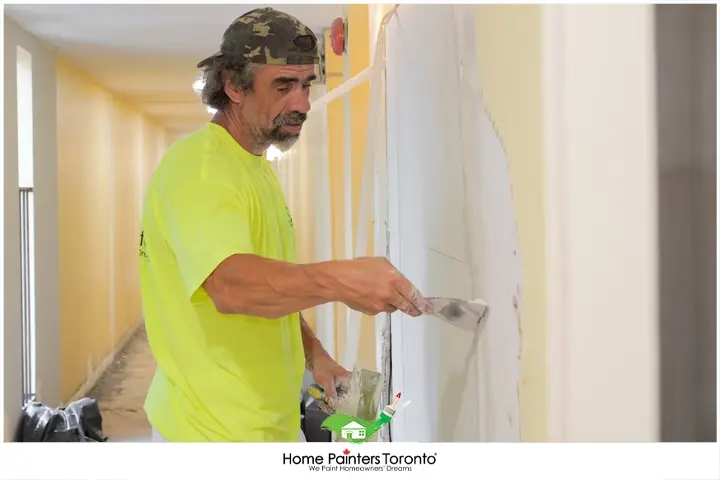
Once you’ve fixed your leak, you’ll want to repair your drywall and repaint after water damage. If you’re a handy person who has plenty of experience with DIY projects around the house,. It can be something you can take care of in a few days. However, re-drywalling can be notoriously difficult, so we always recommend hiring a pro who can save you time, money and effort.
Replacing Water-Damaged Walls
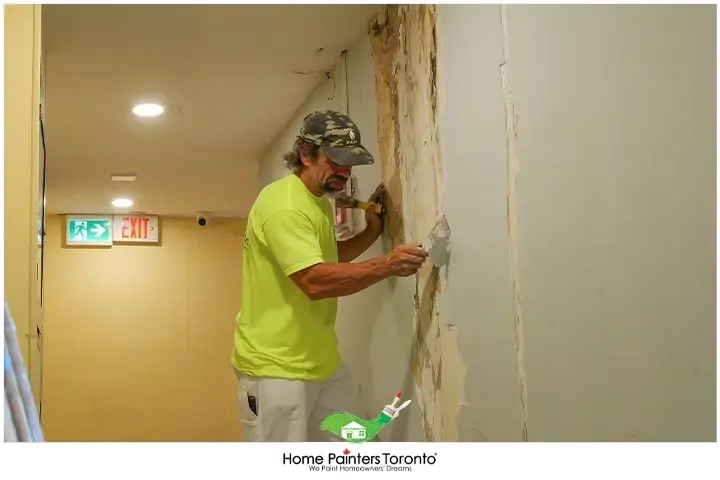
Sometimes, the damage is too severe to repair effectively. Replacement becomes necessary when:
- The drywall has soaked up too much water and is sagging or bulging.
- Mould has spread within the walls.
- The structure of the wall is compromised.
Replacement, although more expensive, ensures the integrity of your structure and safeguards against future damages.
Engaging professionals for a comprehensive inspection is always recommended before making your decision. It helps not only in accurately diagnosing the damage but also in devising a plan tailored to your specific situation.
Preventing Future Leaks
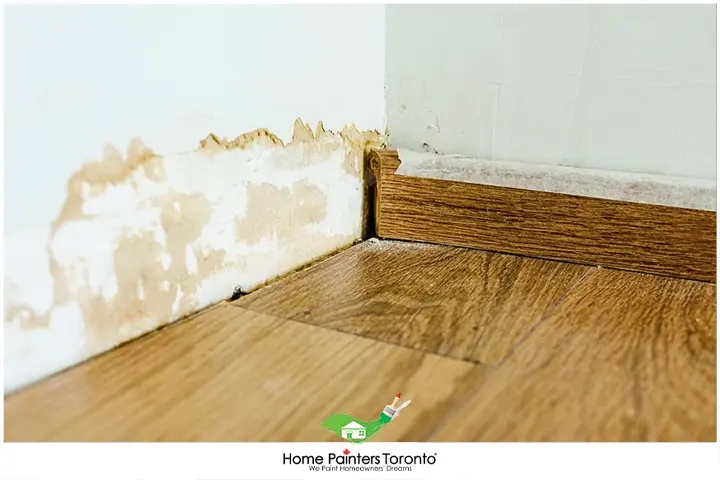
We always recommend regular maintenance for your home, and part of regular maintenance includes ensuring everything looks good. If you can catch a leak before it becomes a big problem, it can save you a lot of money and stress. Here are some tasks you should add to your regular home maintenance.
- Inspect your exterior caulking
- Keep gutters and downspouts clean
- If you have a sprinkler system, have it blown out once a year (preferably before winter hits)
- Ensure the shingles on your roof are in good condition and replace any missing ones
- Test your sump pump and add a battery backup
- Inspect and keep a close eye on drainage patterns around your home
- •Keep your water pressure set to between 40 and 60 psi.
- Add any insulation to pipes that are along exterior walls that aren’t already insulated
TOP BLOGS RELATED TO
“Is Water Seeping Into Your Walls?”
If you’ve experienced water seeping or water damage and you’re looking to have your drywall repaired, call Home Painters Toronto. We can repair and replace damaged drywall and provide a professional paint job that will bring your room back to life. We use only the highest-quality materials while giving you the best price.
Our friendly and trustworthy team of experts will get the job done right the first time. Avoid spending your valuable time and extra money and hire the best team of professionals in the Toronto area with Home Painters Toronto. Our team of experts can take care of your drywall project and get your home looking better than before with a fresh coat of paint. We specialize in drywall repair and interior painting. Please call us at 416.494.9095 or email Brian@HomePaintersToronto.com to get your free quote today. And don’t forget to follow us on all our social channels below!


